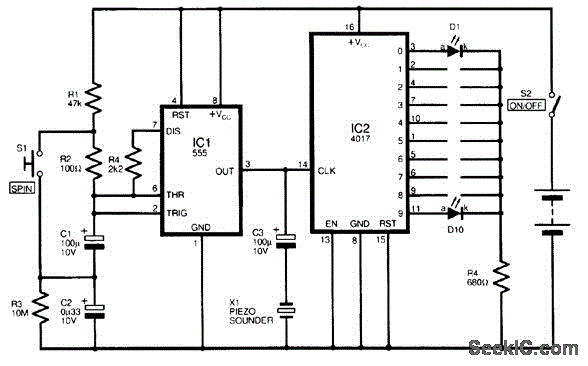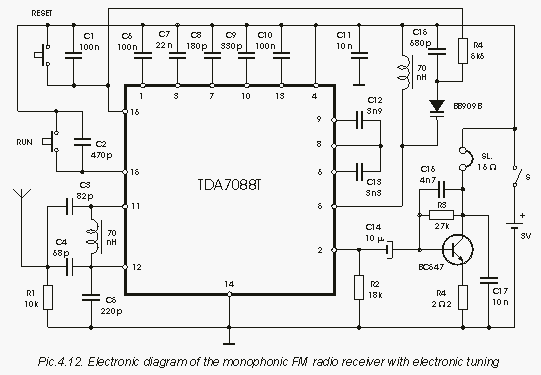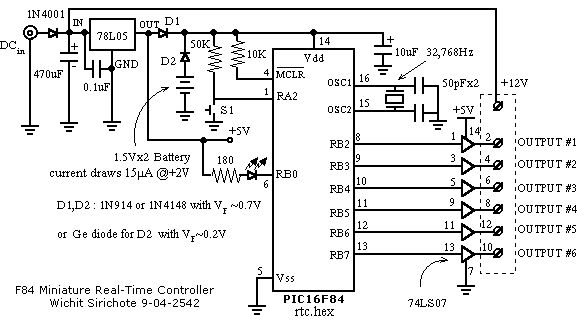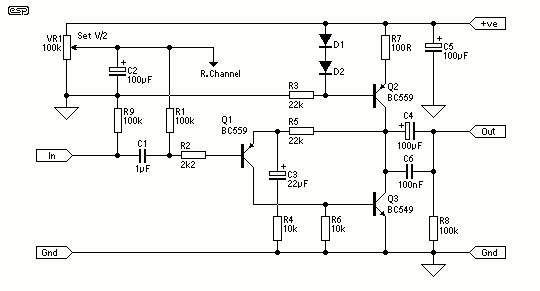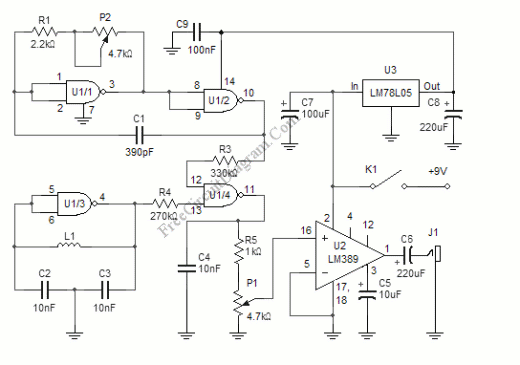
Mini metal detecror (colpitts oscillator)
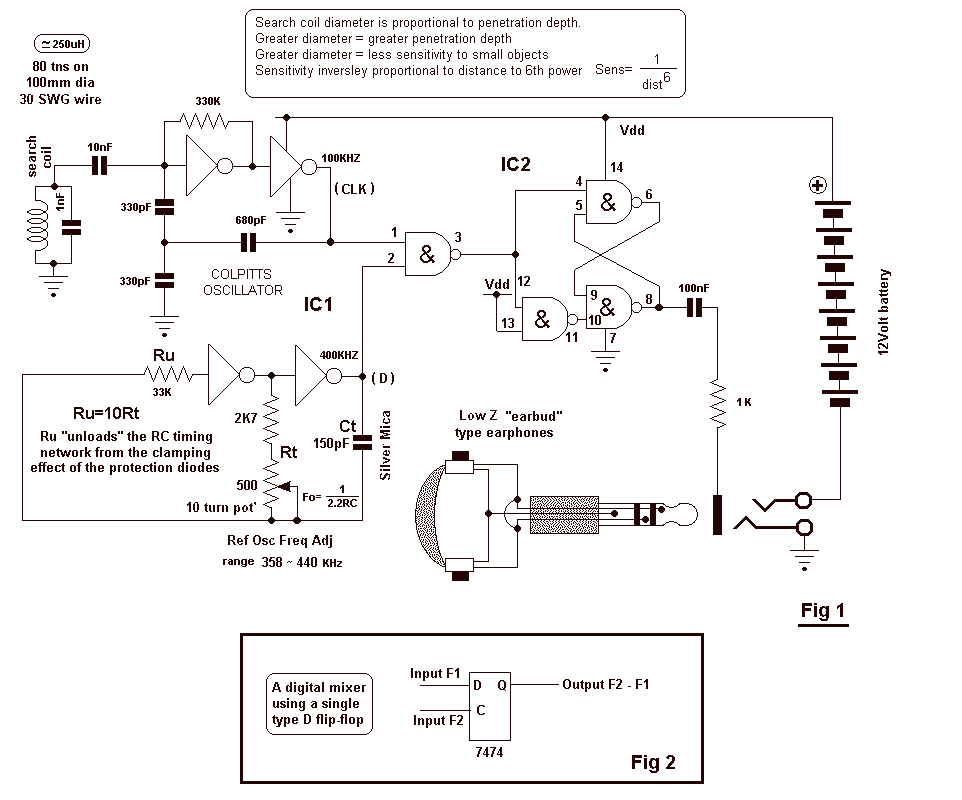
The circuit uses two CMOS ICs. IC1 uses inverters connected as a Colpitts oscillator of 100KHz; the LC frequency determining elements being the search coil and parallel resonating capacitor. An 80 turn close wound 30swg 100mm diameter coil will fit inside the CD case. I will leave the choice of the IC to the reader: this can be any of the well known CMOS inverters or NAND, NOR gates etc configured as inverters. The choice is yours, use whatever you have on hand. IC2 can be either 74C00 or 4011 quad NAND gates. More: When configured as shown the circuit is a "D" type flip-flop (read your theory books!) but in fact acts as a digital mixer.
To quote from Ref 2:
A "D" type flip-flop can be used as a digital mixer to produce the difference between two square waves of different frequencies. (Fig 2).
Assume initially that F1 and F2 are identical in phase and frequency. The D input will be 1 the instant clocking occurs, and the output will be a 1. Now, let the frequency of F1 vary slowly "slip cycles" with respect to F2. The output will alternate at the difference F2 - F1, and we have the equivalent of a digital mixer or down-converter. There are several restrictions to using the circuit. First, both inputs must be fixed or slowly varying square waves; thus you cannot mix several frequencies at once as you can with an analogue circuit. Second, jitter in the output is inherent, for the Q output can drop only immediately after clocking, thus quantizing the output square wave. The worst case jitter is one half clock frequency. For instance, if both clock and D signals are near 1Khz, the worst case jitter can be around half a millisecond. If the frequency difference is less than 50Hz or so, this jitter is tolerable, but as the difference gets larger, the jitter becomes intolerable. Thus the circuit works best when it is taking a small difference between two nearly identical frequencies.
Another limitation (sometimes a handy feature) is that the mixer is harmonic sensitive. For instance, inputs of 10.000 and 10.030 KHz will give you a 30Hz difference frequency. So will a 10KHz and 20.030KHz or 30.030KHz, or any other harmonic difference.
The form of physical construction is as follows: As stated it all fits inside a CD jewel case. The battery is a miniature 12v type used in house cordless doorbell bellpush, key-fob car alarm controls, etc. (i.e., smallest physical size available).
In the absence of an on/off switch, a ring/tip/sleeve audio socket has been used in a way that the negative connection from the battery is completed by the insertion of the earphones plug. Cheap replacement "earbuds" (as used with popular I-PODs) are recommended: plug wiring must be altered as shown in the schematic; left and right "ears" bridged in parallel, then the ring and tip connections act as a switch closure when plugged in, and also connect to the "earthy" side of the circuit.
No volume control is provided; alteration of a 1K earphone series resistor will change things. Components are physically mounted on white cardboard. Discrete component ends are "pushed-thru" and ICs sit in a cut-out area. All connections are soldered using insulated wire and "quigg’s" (pigtail spirals formed by winding small gauge wire around a small drill shaft or sewing needle, etc.) into which all connections are inserted and flowed with solder.
Front and rear cardboard sleeves disguise the contents of the CD case. This metal detector has been used to determine which of a 1 in every 3 packages of popular breakfast cereal contains a battery-operated LED torch (to coerce children to purchase the product). This approach saves buying a lot of boxes of cereal hoping that one may contain the desired free promotion, thus satisfying children's desires.
The circuit is structured around two principal components, the Colpitts oscillator and the digital mixer configuration using a "D" type flip-flop. The oscillator, formed by the search coil and capacitor, generates a frequency of approximately 100 kHz, which is suitable for detecting metallic objects. The choice of CMOS ICs allows for low power consumption and high noise immunity, making the circuit effective for portable applications.
The physical layout of the circuit within a CD case not only provides a compact form factor but also protects the components from external damage. The use of a 12V battery ensures adequate power supply while maintaining a minimal footprint. The innovative use of an audio socket as a switch allows for easy operation without the need for additional mechanical switches, enhancing the user experience.
The digital mixer aspect of the circuit enables the detection of frequency differences, which can be particularly useful in applications requiring precise frequency measurement or signal processing. The inherent jitter and harmonic sensitivity of the mixer are important considerations for users, particularly in scenarios demanding high precision or stability in signal processing.
Overall, this circuit design exemplifies an effective integration of analog and digital components within a compact, user-friendly package, demonstrating versatility in its application for metal detection and frequency analysis.The circuit uses two CMOS IC’s IC1 uses inverters connected as a Colpitts oscillator of 100KHz; the LC frequency determining elements being the search coil and parallel resonating capacitor. An 80 turn close wound 30swg 100mm diameter coil will fit inside the CD case. I will leave the choice of the IC to the reader: this can be any of the well known CMOS inverters or NAND, NOR gates etc configured as an inverters.
The choice is yours, use whatever you have on hand. IC2 can be either 74C00 or 4011 quad NAND gates. When configured as shown the is circuit is a "D" type flip-flop (read your theory books!) but in fact acts as a digital mixer. To quote from Ref 2 : A "D" type flip-flop can be used as a digital mixer to produce the difference between two square waves of different frequencies.
(Fig 2). Assume initially that F1 and F2 are identical in phase and frequency. The D input will be 1 the instant clocking occurs, and the output will be a 1. Now, let the frequency of F1 vary slowly "slip cycles" with respect to F2. The output will alternate at the difference F2 - F1, and we have the equivalent of a digital mixer or down-converter. The are several restrictions to using the circuit. First, both inputs must be fixed or slowly varying square waves; thus you cannot mix several frequencies at once as you can with an analogue circuit.
Second, jitter in the output is inherent, for the Q output can drop only immediately after clocking, thus quantizing the output square wave. The worst case jitter is one half clock frequency. For instance, if both clock and D signals are near 1Khz, the worst case jitter can be around half a millisecond.
If the frequency difference is less than 50Hz or so, this jitter is tolerable, but as the difference gets larger, the jitter becomes intolerable. Thus the circuit works best when it is taking a small difference between two nearly identical frequencies.
Another limitation (sometimes a handy feature) is that the mixer is harmonic sensitive. For instance, inputs of 10.000 and 10.030 KHz will give you a 30Hz difference frequency. So will a 10KHz and 20.030KHz or 30.030KHz, or and other harmonic difference. The form of physical construction is as follows: As stated it all fits inside a CD jewel case. The battery is a miniature 12v type used in; house cordless doorbell bellpush, key-fob car alarm controls etc (ie smallest physical size available) In the absence of an on/off switch I have used a ring/tip/sleeve audio socket in a way that the negative connection from the battery is completed by the insertion of the earphones plug. Cheap replacement "earbuds" (as used with popular I-PODs) are recommended: plug wiring must be altered as shown in the schematic; left and right "ears" bridged in parallel, then the ring and tip connections act as a switch closure when plugged in, and also connect to the "earthy" side of the circuit.
No volume control is provided; alteration of 1K earphone series resistor will change things. Components are physically mounted on white cardboard. Discrete component ends "pushed-thru" and Ics sit in a cut-out area. All connections are soldered using insulated wire and "quigg’s" (pigtail spirals formed by winding small gauge wire around a small drill shaft or sewing needle etc) into which all connections are inserted and flowed with solder. Front and rear cardboard sleeves disguise the contents of the CD case! We have used this metal detector to determine which of a 1 in every 3 package of popular breakfast cereal contains a battery operated LED torch.
(to coerce children to purchase product) Saves buying a lot of boxes of cereal hoping that one MAY contain the desired free promotion, and satisfy the kiddies desire! 🔗 External reference
To quote from Ref 2:
A "D" type flip-flop can be used as a digital mixer to produce the difference between two square waves of different frequencies. (Fig 2).
Assume initially that F1 and F2 are identical in phase and frequency. The D input will be 1 the instant clocking occurs, and the output will be a 1. Now, let the frequency of F1 vary slowly "slip cycles" with respect to F2. The output will alternate at the difference F2 - F1, and we have the equivalent of a digital mixer or down-converter. There are several restrictions to using the circuit. First, both inputs must be fixed or slowly varying square waves; thus you cannot mix several frequencies at once as you can with an analogue circuit. Second, jitter in the output is inherent, for the Q output can drop only immediately after clocking, thus quantizing the output square wave. The worst case jitter is one half clock frequency. For instance, if both clock and D signals are near 1Khz, the worst case jitter can be around half a millisecond. If the frequency difference is less than 50Hz or so, this jitter is tolerable, but as the difference gets larger, the jitter becomes intolerable. Thus the circuit works best when it is taking a small difference between two nearly identical frequencies.
Another limitation (sometimes a handy feature) is that the mixer is harmonic sensitive. For instance, inputs of 10.000 and 10.030 KHz will give you a 30Hz difference frequency. So will a 10KHz and 20.030KHz or 30.030KHz, or any other harmonic difference.
The form of physical construction is as follows: As stated it all fits inside a CD jewel case. The battery is a miniature 12v type used in house cordless doorbell bellpush, key-fob car alarm controls, etc. (i.e., smallest physical size available).
In the absence of an on/off switch, a ring/tip/sleeve audio socket has been used in a way that the negative connection from the battery is completed by the insertion of the earphones plug. Cheap replacement "earbuds" (as used with popular I-PODs) are recommended: plug wiring must be altered as shown in the schematic; left and right "ears" bridged in parallel, then the ring and tip connections act as a switch closure when plugged in, and also connect to the "earthy" side of the circuit.
No volume control is provided; alteration of a 1K earphone series resistor will change things. Components are physically mounted on white cardboard. Discrete component ends are "pushed-thru" and ICs sit in a cut-out area. All connections are soldered using insulated wire and "quigg’s" (pigtail spirals formed by winding small gauge wire around a small drill shaft or sewing needle, etc.) into which all connections are inserted and flowed with solder.
Front and rear cardboard sleeves disguise the contents of the CD case. This metal detector has been used to determine which of a 1 in every 3 packages of popular breakfast cereal contains a battery-operated LED torch (to coerce children to purchase the product). This approach saves buying a lot of boxes of cereal hoping that one may contain the desired free promotion, thus satisfying children's desires.
The circuit is structured around two principal components, the Colpitts oscillator and the digital mixer configuration using a "D" type flip-flop. The oscillator, formed by the search coil and capacitor, generates a frequency of approximately 100 kHz, which is suitable for detecting metallic objects. The choice of CMOS ICs allows for low power consumption and high noise immunity, making the circuit effective for portable applications.
The physical layout of the circuit within a CD case not only provides a compact form factor but also protects the components from external damage. The use of a 12V battery ensures adequate power supply while maintaining a minimal footprint. The innovative use of an audio socket as a switch allows for easy operation without the need for additional mechanical switches, enhancing the user experience.
The digital mixer aspect of the circuit enables the detection of frequency differences, which can be particularly useful in applications requiring precise frequency measurement or signal processing. The inherent jitter and harmonic sensitivity of the mixer are important considerations for users, particularly in scenarios demanding high precision or stability in signal processing.
Overall, this circuit design exemplifies an effective integration of analog and digital components within a compact, user-friendly package, demonstrating versatility in its application for metal detection and frequency analysis.The circuit uses two CMOS IC’s IC1 uses inverters connected as a Colpitts oscillator of 100KHz; the LC frequency determining elements being the search coil and parallel resonating capacitor. An 80 turn close wound 30swg 100mm diameter coil will fit inside the CD case. I will leave the choice of the IC to the reader: this can be any of the well known CMOS inverters or NAND, NOR gates etc configured as an inverters.
The choice is yours, use whatever you have on hand. IC2 can be either 74C00 or 4011 quad NAND gates. When configured as shown the is circuit is a "D" type flip-flop (read your theory books!) but in fact acts as a digital mixer. To quote from Ref 2 : A "D" type flip-flop can be used as a digital mixer to produce the difference between two square waves of different frequencies.
(Fig 2). Assume initially that F1 and F2 are identical in phase and frequency. The D input will be 1 the instant clocking occurs, and the output will be a 1. Now, let the frequency of F1 vary slowly "slip cycles" with respect to F2. The output will alternate at the difference F2 - F1, and we have the equivalent of a digital mixer or down-converter. The are several restrictions to using the circuit. First, both inputs must be fixed or slowly varying square waves; thus you cannot mix several frequencies at once as you can with an analogue circuit.
Second, jitter in the output is inherent, for the Q output can drop only immediately after clocking, thus quantizing the output square wave. The worst case jitter is one half clock frequency. For instance, if both clock and D signals are near 1Khz, the worst case jitter can be around half a millisecond.
If the frequency difference is less than 50Hz or so, this jitter is tolerable, but as the difference gets larger, the jitter becomes intolerable. Thus the circuit works best when it is taking a small difference between two nearly identical frequencies.
Another limitation (sometimes a handy feature) is that the mixer is harmonic sensitive. For instance, inputs of 10.000 and 10.030 KHz will give you a 30Hz difference frequency. So will a 10KHz and 20.030KHz or 30.030KHz, or and other harmonic difference. The form of physical construction is as follows: As stated it all fits inside a CD jewel case. The battery is a miniature 12v type used in; house cordless doorbell bellpush, key-fob car alarm controls etc (ie smallest physical size available) In the absence of an on/off switch I have used a ring/tip/sleeve audio socket in a way that the negative connection from the battery is completed by the insertion of the earphones plug. Cheap replacement "earbuds" (as used with popular I-PODs) are recommended: plug wiring must be altered as shown in the schematic; left and right "ears" bridged in parallel, then the ring and tip connections act as a switch closure when plugged in, and also connect to the "earthy" side of the circuit.
No volume control is provided; alteration of 1K earphone series resistor will change things. Components are physically mounted on white cardboard. Discrete component ends "pushed-thru" and Ics sit in a cut-out area. All connections are soldered using insulated wire and "quigg’s" (pigtail spirals formed by winding small gauge wire around a small drill shaft or sewing needle etc) into which all connections are inserted and flowed with solder. Front and rear cardboard sleeves disguise the contents of the CD case! We have used this metal detector to determine which of a 1 in every 3 package of popular breakfast cereal contains a battery operated LED torch.
(to coerce children to purchase product) Saves buying a lot of boxes of cereal hoping that one MAY contain the desired free promotion, and satisfy the kiddies desire! 🔗 External reference
